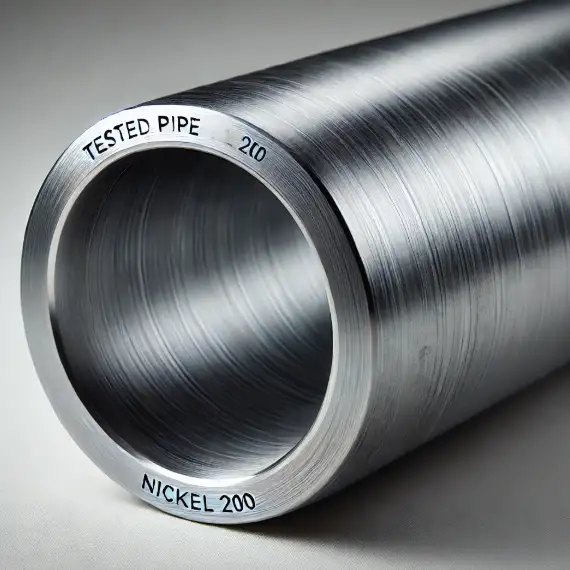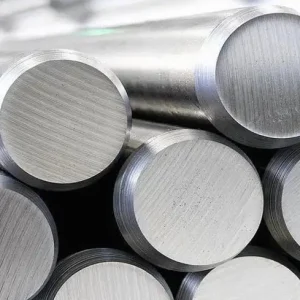Nickel 200 tubing (UNS N02200) is a commercially-pure nickel tube grade that combines exceptional resistance to reducing and neutral corrosive environments with good mechanical strength and high thermal/electrical conductivity — making it a practical, cost-effective choice for chemical process piping, heat exchangers, instrumentation and aerospace hydraulic lines where oxidizing conditions are limited. For most users who need excellent resistance to caustics, low contamination and reliable fabrication properties, Nickel 200 tubing offers the best balance of purity, formability and availability in 2025; MWAlloys supplies factory-priced Nickel 200 tubing from China with fast stock delivery for global projects.
What is Nickel 200 tubing?
Nickel 200 is the commercial name for UNS N02200 — a wrought, commercially-pure nickel alloy (nominal Ni ≥ 99.0%). In tubing form it is most commonly supplied to ASTM/ASME tube and pipe specifications for use where reducing or neutral chemistries, caustic alkalis, and high thermal or electrical conductance are required. The alloy is often selected where product purity is critical (food, pharmaceuticals, specialty chemical lines) and where resistance to caustic corrosion (including molten caustics) is required, provided strongly oxidizing media are avoided.
Chemical composition (typical limits for Nickel 200 / UNS N02200)
| Element | Typical / Specified (%) |
|---|---|
| Nickel (Ni) | ≥ 99.0 |
| Carbon (C) | ≤ 0.15 |
| Iron (Fe) | ≤ 0.40 |
| Manganese (Mn) | ≤ 0.35 |
| Silicon (Si) | ≤ 0.35 |
| Copper (Cu) | ≤ 0.25 |
| Sulfur (S) | ≤ 0.01 |
Notes: Specifications vary slightly by standard and producer; the table above reflects commonly quoted limits for Nickel 200 tubing. For low-carbon service at elevated temperature, Nickel 201 (UNS N02201) is often chosen.
Material physical & mechanical properties
| Property | Typical value (metric) | Typical value (imperial) |
|---|---|---|
| Density | ~8.89 g/cm³ | ~0.321 lb/in³ |
| Melting range | 1,435–1,446 °C | 2,615–2,635 °F |
| Tensile strength (annealed) | ~380–462 MPa (depending source/test) | ~55,000–67,000 psi |
| Yield strength (0.2% offset) (annealed) | ~105–215 MPa (varies by product form & spec) | ~15,000–31,500 psi |
| Elongation (in 2") | 30–45% (annealed) | 30–45% |
| Electrical conductivity | lower than Cu but high for Ni alloys — good conductor among Ni alloys | — |
| Magnetic behavior | Ferromagnetic at room temperature | — |
Interpretation: Mechanical numbers vary with cold working, tube OD/wall and heat treatment. Always request mill test reports for project acceptance.
Standards & specifications
Common tubing and pipe standards for Nickel 200:
-
ASTM B161 / ASME SB161 — Cold-worked seamless nickel tubing/pipe. (tubing/pipe)
-
ASTM B163 / ASME SB163 — Cold-worked seamless nickel tubing (another common tubular spec).
-
ASTM B725 — Nickel welded tubing (small diameter / instrumentation).
-
DIN / EN equivalencies sometimes list Nickel 200 under 2.4066 (in historic DIN numbering) — verify local standards.
When specifying, include: UNS number (N02200), product form (seamless/ERW), condition (annealed/cold worked), required certification (EN 10204 3.1/3.2 or equivalent), and any NDT / PMI / traceability requirements.
Forms, manufacturing and typical dimensions
Nickel 200 tubing is manufactured as:
-
Seamless or ERW welded tube for larger diameters
-
Cold-drawn and bright-annealed tubing for small OD / instrumentation lines (tight tolerances)
-
Coiled U-tubes for heat exchangers (bright annealed for cleanliness)
Typical stocked tubing sizes vary by supplier; a representative stocked range for tubing is:
-
OD range (tubing): 1/8" (.125") up to 1.5" or greater for small bore tubing; pipe/pipe OD for seamless goes larger (½" to 6"+ for pipe stock). Wall thickness varies from .020" to .100"+ depending on schedule.
What is Nickel 200 tubing used for?
Key application areas where Nickel 200 tubing excels:
-
Chemical processing & caustic handling — especially for non-oxidizing acids and caustic alkalis, and for equipment that must avoid contamination of product streams.
-
Heat exchangers and condenser tubing — when low-contamination and good thermal conductivity are desired.
-
Aerospace fuel/hydraulic/instrument lines — where formability, ductility and reliable fabrication are essential.
-
Food, pharmaceutical & electronics — due to the alloy’s high purity and resistance to contamination.
-
Electrical / resistance heating elements, thermocouples & specialty parts — uses the alloy’s thermal/electrical behavior.
Limitation: Nickel 200 should not be used in strongly oxidizing environments (e.g., nitric acid at moderate concentrations and temperatures) without additional evaluation.
Fabrication, welding and heat treatment notes
-
Welding: Nickel 200 is readily weldable by conventional methods; matching filler metals (Nickel filler) are normally used. Pre/post heat treatments depend on product form and service conditions.
-
Forming: Good cold-workability and formability; heavy forming is typically performed at elevated temperatures (see manufacturer guidance).
-
Annealing: Typical anneal ranges around 650–950 °C (specific anneal practices vary by supplier and product). Confirm recommended cycles with mill datasheet.
Always request fabrication guidance and qualified welding procedures for critical systems.
Nickel 200 tubing sizes — thickness and weight
Below is a representative selection of common tubing sizes and the approximate weights. These are illustrative; actual weights depend on OD, wall thickness and manufacturing tolerances. For project procurement use the manufacturer’s weight tables or schedules.
Small-bore tubing (example)
| Nominal OD (inch) | Wall (inch) | Approx. weight (lb/ft) |
|---|---|---|
| 1/8" (0.125") | 0.020" | 0.03 |
| 1/4" (0.250") | 0.035" | 0.07 |
| 3/8" (0.375") | 0.035" | 0.12 |
| 1/2" (0.500") | 0.049" | 0.21 |
| 3/4" (0.750") | 0.060" | 0.39 |
Pipe / larger tubing (Schedule style, example)
| Nominal Pipe Size | Outside Diameter | Wall (Schedule 40) | Approx. weight (lb/ft) |
|---|---|---|---|
| 1/2" NPS | 0.840" | 0.109" | 1.1 |
| 1" NPS | 1.315" | 0.133" | 2.4 |
| 2" NPS | 2.375" | 0.154" | 6.9 |
Sources & sample stock lists from major tube distributors show OD/wall and stocked ranges for Alloy 200 tubing; confirm precise weights with supplier catalogs.
Cross-references & equivalents
-
UNS: N02200 (Nickel 200) and N02201 (Nickel 201 — lower C).
-
EN / DIN: historic DIN numeric 2.4066 is commonly associated with commercially-pure nickel (check local code).
-
Similar commercial names: Alloy 200, Alloy 200 Nickel; vendors may use trade brands (e.g., VDM Nickel 200). Always specify UNS number and required standard to avoid confusion.
2025 price comparison (United States, Europe, China)
Market prices for Nickel 200 tubing vary with nickel commodity prices, tube size, quantity, certifications, surface finish, and freight. Below we summarize indicative market ranges observed in mid-2025; treat these as purchasing guidance — get firm supplier quotes for project budgeting.
Price per kg (representative ranges, mid-2025):
-
United States (distributor/imported tubing): ~US$25–50 / kg for finished Nickel 200 tubing (smaller inventory/finished product commands premiums).
-
Europe (distributors / mills): ~US$28–55 / kg (variability from stock, testing, certifications and higher logistics costs). Use local mills/distributors for quotes.
-
China (factory FOB / large lots): ~US$26–50 / kg (many Chinese mills list packed/FOB rates in this band; small-lot/express stock may be slightly higher). Alibaba and Made-in-China listings commonly show per-kg pricing in the $26–50/kg window depending on MOQ and finish.
Interpretation & procurement notes:
-
Raw nickel metal price (LME/spot) heavily influences finished tubing price; regional premiums and processing costs add to the base metal cost.
-
Small diameter, instrument-grade bright annealed tubing often carries a higher premium per kg than larger, plain seam-welded pipe.
-
Certifications (3.1/3.2 test reports, PMI, NDT) and traceability add cost; factor these into budget.
-
Large projects should negotiate long-lead contracts or frame agreements with MWAlloys to lock price/lead time and receive factory direct pricing.
Procurement checklist
-
Mill / Manufacturer Certificate (UNS N02200, ASTM spec called out — e.g., ASTM B161).
-
EN 10204 / 3.1 or 3.2 test report (chemical, mechanical).
-
Heat number & traceability and heat treatment condition.
-
Dimensional tolerances and OD/wall schedule confirmation.
-
Surface finish & post-processing (bright anneal, pickling if required).
-
Welding / fabrication guidance and recommended fillers (if the tube will be welded on site).
-
Delivery schedule / MOQ / packaging (coils vs straight lengths).
-
Any PMI / NDT reports required by project spec.
MWAlloys can provide all the above as standard for project orders and offers 100% factory pricing for competitive quotes.
FAQs
-
Is Nickel 200 magnetic?
Yes. Nickel 200 is ferromagnetic at room temperature (unlike many stainless steels). -
When should I pick Nickel 201 instead?
Choose Nickel 201 (lower carbon) when you need better resistance at elevated temperatures where carbon-induced embrittlement risk or carbide formation matters. -
Can Nickel 200 be used in seawater?
It has limited seawater resistance; Monel 400 or higher alloyed Ni-Cr-Mo grades are preferred for prolonged seawater service. Evaluate velocity, oxygenation and fouling factors before use. -
Is Nickel 200 weldable to stainless steel?
Yes, but use compatible nickel filler metals and follow qualified procedures to avoid galvanic or metallurgical issues. -
Can Nickel 200 be used in oxidizing acids?
No, Nickel 200 performs poorly in strongly oxidizing acids (e.g., nitric acid) — select specialized alloys for these media. -
What minimum documentation is typical for export tubing?
EN 10204 3.1 / 3.2, chemical & mechanical test certificates, heat number traceability, and PMI if requested. -
How is small-bore instrument tubing different price-wise?
Small-bore, cold-drawn, bright annealed tubing carries higher per-kg cost due to tighter tolerances and finishing. -
Will MWAlloys ship samples?
Yes, MWAlloys offers sample lengths for quality evaluation; contact sales for fast dispatch from stock. (company statement) -
Typical lead time for stocked sizes?
For stocked sizes MWAlloys typically ships quickly (days to 2 weeks) depending on order size and destination; for special dimensions allow longer. -
What tests should I require for critical piping?
Chemical analysis, tensile & yield, hardness, and where applicable PMI, UT or eddy current, and hydrotest per project code.
Why choose MWAlloys for Nickel 200 tubing?
-
Factory direct pricing: MWAlloys supplies Nickel 200 tubing at 100% factory prices—no distributor markup for most standard sizes.
-
Fast stock delivery: We maintain inventory of common OD/wall combinations for expedited global dispatch.
-
Project support: Full technical support — mill test certificates, material datasheets, and fabrication guidance on request.
-
Quality control: We cooperate with certified mills and run pre-shipment inspections and traceability documentation.
Procurement examples
A chemical plant replacing aged piping selected Nickel 200 tubing for caustic feed lines (cold, reducing service). MWAlloys supplied ASTM B161 cold-drawn tubing with EN 10204 3.1 certificates. The selection reduced product contamination, simplified welding procedures versus exotic alloys, and delivered full traceability for QA audits.





